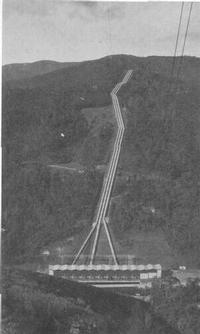


Chapter 6
I Construction During The Settlement Years
II The Use Of Timber As A Structural Material
III Structural Steel
IV Concrete Technology
V Housing
VI Industrialised Pre-cast Concrete Housing
VII Ports And Harbours
VIII Roads
IX Heavy Foundations
X Bridges
XI Sewerage
XII Water Engineering
i Pipelines
ii Tunnels
iii Dams
iv Power Stations
XIII Railways
XIV Major Buildings
XV Airports
XVI Thermal Power Stations
XVII Materials Handling
XVIII Oil Industry
XIX The Snowy Mountains Scheme
XX The Sydney Opera House
XXI The Sydney Harbour Bridge
XXII Hamersley Iron
XXIII North West Shelf
Sources and References
Index
Search
Help
Contact us

Pipelines
Woodstave PipelinesA woodstave pipeline consists of wooden planks held into a barrel section by iron or steel wire. The attractions of the woodstave pipeline in forested areas were that it made use of locally available material and also that the pipe could be assembled by hand on site, thus avoiding the transport of large components. A further important consideration was that the pipe maintained roughly the same discharge capacity over its life span of 50 years because the interior surface remained smooth. A typical woodstave pipeline 250 mm diameter and 50 km long was installed at Hamilton 300 km west of Melbourne in 1933. Much larger woodstave pipelines have been used in hydroelectric practice. The Wayatinah pipeline in Tasmania is 4100 mm diameter and is 1265 m long.
Concrete Pipelines
The technique of making concrete pipes using a rapidly rotating mould to compact the concrete under the influence of centrifugal force was developed in Australia in the 1920s (see p. 16). Concrete pipes both reinforced and pre-stressed were extensively used in aquaduct construction for the Snowy Mountains Scheme between 1952 and 1966. In the Geehi River aquaduct pre-stressed concrete pipes up to 1670 mm diameter were used.
Fibro-cement Pipelines
For small diameters and moderate working pressures the most practicable method of reinforcement is to incorporate fibres in the concrete. Originally asbestos fibres were used but more recently a switch has been made to cellulose. Fibre cement pipes are very popular for suburban reticulation of water because they are the least expensive type of pipe to buy and are usually the most economical. Whilst the original technology for this type of pipe was imported, Australian engineering has been responsible for significant technical improvements and innovations in design and manufacture.
In the late 1920s and 30s pipes were made by the Sutton process. Sutton was an Australian executive employed by James Hardie Industries Limited, who developed his process to obviate the need for the purchase of high capital cost machinery from Europe. Sutton was appointed a Foundation Director of James Hardie Industries Limited in 1925. In essence the process consisted of wrapping an uncured flat sheet produced by the Hatschek process around a steel mandrel, covering with a layer of fabric, and compacting the material by several turns of a tensioned steel cable wrapped around the assembly and progressively wound along the length of the pipe. The pipe and mandrel were removed from the compacting machine, the mandrel removed when the pipe was sufficiently hardened, and the pipe water cured.
Iron and Steel Pipelines
Where the working pressure and diameter exceed the capabilities of concrete pipes, iron or steel pipes have been used. For diameters up to 750 mm 'ductile iron' pipes made from cast iron in a centrifugal casting machine have been produced in Australia since 1962. For larger diameters wrought iron or steel plate pipelines are being used. The famous Coolgardie Water Supply Scheme in Western Australia of 1905 used mild steel plate with rivetted joints (O'Brien 1918). The length of about 500 km was remarkable. Long water supply pipelines have also been built more recently in other States.
In hydroelectric practice many high pressure pipelines have been built. Some notable examples are the Kiewa No. 1 pipeline Victoria (Rufenacht 1962), the Poatina pipeline, Tasmania (Colebatch et al. 1959), and the Murray 1 pipelines (Fig. 40), New South Wales, (Dann and Anderson 1966). the first two examples used banded pipelines for the high pressure sections which were imported fully manufactured from Europe. These banded pipelines consist of a steel cylinder onto which are placed high tensile thick steel bands. The Murray 1 pressure pipelines were the first use of medium tensile steel for pipelines in Australia. The steel was manufactured by BHP. Associated with the Murray 1 pressure pipelines was a large amount of development work in connection with welding and inspection procedures which considerably raised the level of technical expertise in this field in Australia.

Organisations in Australian Science at Work - James Hardie and Co. Pty Ltd; Snowy Mountains Hydro-Electric Scheme
People in Bright Sparcs - Price, Douglas G.; Sutton, John
 |
Australian Academy of Technological Sciences and Engineering |  |
© 1988 Print Edition pages 367 - 369, Online Edition 2000
Published by Australian Science and Technology Heritage Centre, using the Web Academic Resource Publisher
http://www.austehc.unimelb.edu.au/tia/369.html